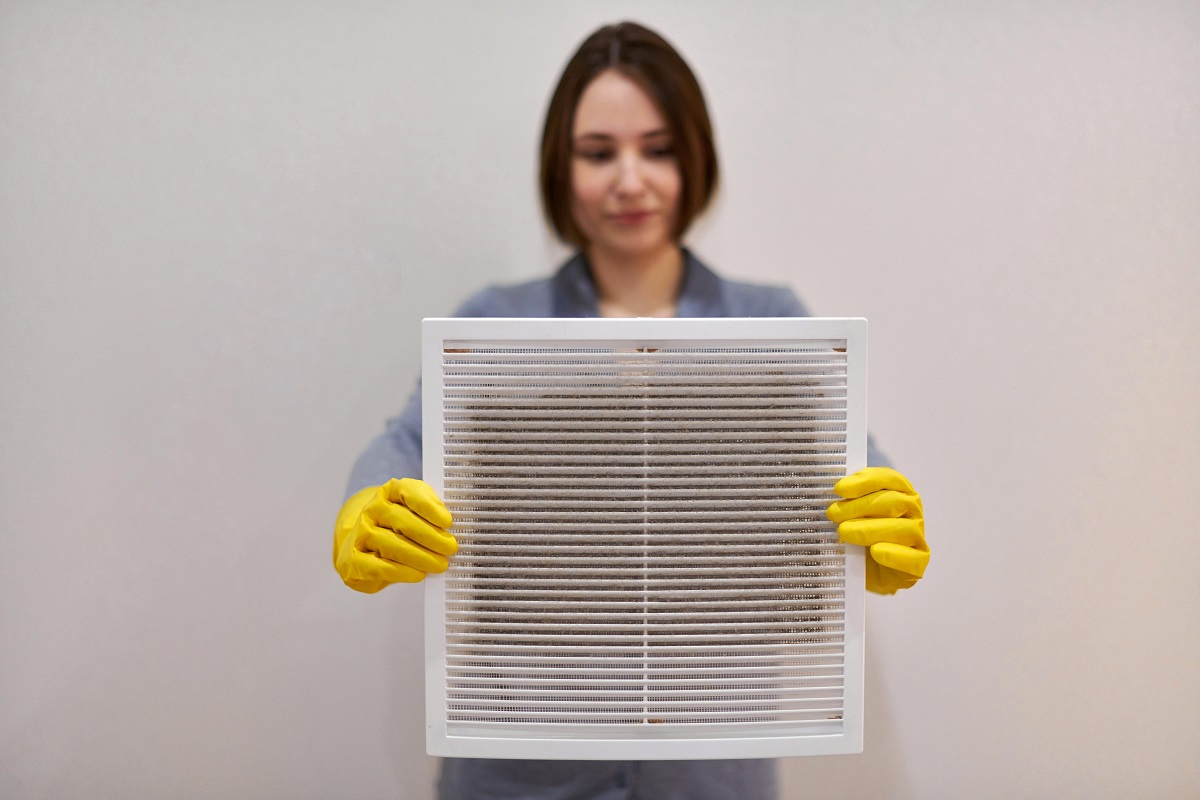The Comprehensive Home Environmental Health Assessment: Your New Advantage

Standard inspections miss invisible risks. Learn how a proactive home wellness evaluation of air, water, and EMFs can differentiate your properties, build trust, and unlock new value. Are your properties truly healthy.
Table of Contents
- Why Isn't a Standard Environmental Home Inspection Enough Anymore?
- What Are the Core Pillars of a Comprehensive Assessment?
- How Do You Turn Assessment Data into a Business Advantage?
- Frequently Asked Questions
Differentiate Your Properties: A Guide to the Comprehensive Home Environmental Health Assessment
A comprehensive home environmental health assessment is a data-driven evaluation that analyzes a property's invisible environmental factors, including its air, water, and electromagnetic fields, going far beyond a standard visual inspection. For real estate agents, property managers, and developers, understanding and leveraging these assessments is no longer a luxury—it’s the new standard for standing out in a crowded market and meeting the demands of health-conscious clients. This detailed guide explains what a truly effective assessment involves and how you can use it to enhance your value proposition, manage risks before they arise, and build a new level of unparalleled trust with your customers and tenants.
Key Takeaways
- A comprehensive home environmental health assessment is a data-driven evaluation that goes far beyond a standard inspection, covering crucial areas like air quality, water safety, EMF exposure, mold risk, and hidden toxins.
- Leveraging a professional home health check-up allows real estate and property management professionals to proactively address environmental issues, differentiate their offerings, and satisfy the growing demand for healthy living spaces.
- Nestwell's platform translates complex scientific data into an easy-to-understand Home Health Score and a detailed Home Health Report, complete with clear, actionable recommendations.
- Achieving a "Nestwell Certified" status through our healthy home certification services provides a powerful marketing tool that can increase property value, attract premium clients, and build lasting trust in your brand.
Why Isn't a Standard Environmental Home Inspection Enough Anymore?
For decades, the standard inspection has been a cornerstone of property transactions. A standard environmental home inspection is excellent for spotting major structural issues, visible water damage, or an outdated electrical system that requires immediate attention. It gives buyers a necessary overview of the home's physical condition and integrity. But what about the significant risks you can't see? The modern understanding of a healthy home has evolved beyond just its structure; it now includes the very environment within its walls.
The limitations of a traditional inspection lie in what it overlooks. These evaluations were not designed to measure the invisible world that directly impacts occupant well-being. A home can be structurally perfect yet still pose health challenges to its residents due to unseen environmental factors.
Standard inspections frequently miss critical data points, including:
- Microscopic Air Pollutants: They cannot detect microscopic particulates (like PM2.5) or Volatile Organic Compounds (VOCs) that are released from paint, new furniture, and common cleaning products.
- Hidden Water Contaminants: A visual check does not reveal the presence of heavy metals, chlorine byproducts, pesticides, or other chemical contaminants that may be present in the tap water.
- Electromagnetic Field Levels: High levels of EMF (electromagnetic fields) emanating from improper wiring, household appliances, or nearby power lines are completely invisible to a standard inspector.
- Future Mold Conditions: An inspector can spot existing, visible mold, but they do not measure the underlying conditions of humidity and poor ventilation that create the perfect breeding ground for future mold growth.
This is exactly where a proactive home wellness evaluation completely changes the game for property professionals. Instead of adopting a reactive stance and waiting for a problem to manifest—like a tenant complaint about musty smells or a buyer's concern about air quality—you can use scientific data to identify and address these risks before they affect resident health or your company’s bottom line.
Truly understanding how to assess home health requires a systematic, multi-point approach. It involves quantifying the environmental quality of a space using specialized equipment and lab analysis. This process transforms guesswork and vague assurances into a clear, data-backed picture of a home’s health. For professionals in real estate and property management, this proactive approach offers a powerful way to demonstrate value and care, moving from simply managing a property to actively enhancing its quality of life.
What Are the Core Pillars of a Comprehensive Assessment?
A truly comprehensive assessment methodically tests several key pillars of a healthy indoor environment. It's a holistic investigation that goes deep into the elements we interact with every day. Here’s what you should be looking for in a top-tier evaluation to ensure you have a complete picture of a property’s health.
How Does Residential Indoor Air Quality Testing Work?
It is a well-known fact that most people spend around 90% of their time indoors, which makes the quality of the air we breathe at home a critical factor for our long-term health and daily well-being. Professional indoor air quality testing residential services are designed to measure what the naked eye cannot see, providing a scientific snapshot of the air inside a property. This isn't just about dust; it's about identifying a wide range of microscopic airborne contaminants that can affect comfort, trigger allergies, and contribute to health issues over time. The process involves using advanced sensors and collecting air samples for laboratory analysis to provide precise measurements.
When conducting a thorough air quality test, here are the common toxic substances in home air to test for:
- Volatile Organic Compounds (VOCs): These are gases released from many common household items, including paints, new furniture, carpets, air fresheners, and cleaning products. High levels can cause headaches, dizziness, and irritation.
- Particulate Matter (PM2.5): These are fine, inhalable particles that are smaller than 2.5 micrometers. They can come from cooking, burning candles, dust, and outdoor pollution that seeps inside. These tiny particles can get deep into the lungs.
- Formaldehyde: A specific and common VOC, formaldehyde is often found in building materials like pressed-wood products (plywood, particleboard), glues, and certain fabrics. It is a known irritant.
- Carbon Monoxide (CO): While most homes have CO detectors, a professional assessment can check for low-level leaks from fuel-burning appliances, ensuring complete safety.
Nestwell’s platform takes this complex data and translates it into an understandable score. It analyzes the levels of these pollutants and provides clear, practical recommendations, such as which specific types of air purifiers are most effective for the identified issues, which houseplants can help filter the air, or when to implement a strategy for increased ventilation.
What Hidden Dangers in Tap Water Can a Professional Service Find?
Municipal water treatment facilities do an incredible job of providing safe drinking water to communities. However, the water’s journey doesn't end there. From the treatment plant to a property’s tap, water travels through miles of pipes, some of which can be decades old. A dedicated home water quality testing service is the only way to be certain of what comes out of the faucet inside a specific home or apartment unit. This process involves collecting water samples directly from the tap and sending them to a certified laboratory for detailed chemical analysis.
There can be many hidden dangers in tap water that a professional test can identify, including:
- Lead: Often leaches from aging lead pipes, solder, or brass fittings. Even low levels of lead exposure are a significant health concern, especially for children.
- Chlorine and Byproducts: While chlorine is essential for disinfecting water, it can react with organic matter to form disinfection byproducts (DBPs), which have been linked to health risks.
- Pesticides and Industrial Runoff: In some areas, agricultural or industrial runoff can find its way into the water supply, introducing chemicals that are not always removed by standard municipal treatment.
- Unbalanced pH Levels: Water that is too acidic can corrode pipes, potentially leaching metals into the water. Water that is too alkaline can cause skin irritation and scale buildup in plumbing.
This is another area where Nestwell provides immense value. Our Home Health Report breaks down the property’s water quality analysis in simple terms. It doesn't just present you with numbers; it tells you what they mean and connects you with specific, effective filtration solutions from our curated marketplace, whether it’s a simple faucet filter or a whole-home system.
What Other Invisible Threats Should You Test For?
A truly holistic assessment doesn't stop at air and water. It examines the entire living environment for other invisible stressors that can impact a resident’s well-being and a property’s long-term value.
- EMF Exposure: With smart homes becoming the new standard, EMF radiation testing home is now a key part of a modern health assessment. It measures the electric and magnetic fields emitted from sources like electrical wiring within walls, large appliances, Wi-Fi routers, and other wireless devices. For a growing number of health-conscious clients, having data on EMF levels provides essential peace of mind and demonstrates a commitment to modern wellness concerns.
- Mold Risk: A proactive approach is far more valuable than a reactive one. Instead of just looking for visible mold spots, a forward-thinking mold risk assessment home analyzes the environmental conditions that allow mold to thrive. It measures ambient humidity levels, identifies areas with poor ventilation, and uses thermal imaging to find hidden moisture behind walls. This helps prevent future growth, saving property owners thousands of dollars in expensive remediation costs and protecting residents from mold-related health issues.
- Environmental Toxins: A complete safety profile of a property requires looking for hazards in the building materials themselves. Professional residential environmental toxins detection can test for the presence of legacy materials like asbestos fibers in old insulation or tiles and check for lead in old paint, especially in properties built before 1978. Identifying these materials is crucial before any renovation work is planned and provides full transparency to potential buyers or tenants.
The unique power of the Nestwell platform is its ability to integrate all these distinct and complex data points seamlessly. Our system consolidates the findings from air, water, EMF, mold risk, and toxins into one cohesive, easy-to-understand report, giving you a single source of truth for a property’s complete environmental health.
How Do You Turn Assessment Data into a Business Advantage?
Collecting data on a home’s environmental health is the first step, but the real value for B2B professionals lies in how you can leverage these insights to drive tangible business goals. Raw data can be overwhelming; its power is unlocked when it is transformed into simple, actionable tools that enhance your marketing, operations, and client relationships.
Step 1: Simplify Complexity with a Home Health Score
The concept is simple: think of it like a credit score, but for a property’s wellness. Understanding home health score metrics is designed to be intuitive. It's an at-a-glance number that instantly communicates the overall environmental quality of a home to potential buyers, tenants, or clients. Instead of having to explain complex charts about VOC levels or water pH, you can present a single, credible score that summarizes the property’s standing.
This score is calculated by analyzing the results from all pillars of the comprehensive assessment—air, water, EMF, and more. A high score immediately signals that the property meets a superior standard for healthy living.
Business Benefit: For real estate agents and developers, the Home Health Score becomes a powerful marketing tool. You can feature it prominently in listings, brochures, and online advertising. In a sea of properties all boasting "great location" and "modern finishes," a high Home Health Score is a unique, data-backed differentiator. It allows you to quickly and effectively communicate that a property is not just beautiful, but also a healthy place to live, instantly elevating its perceived value.
Step 2: Provide Actionable Insights with a Home Health Report
While the score provides the "what," the report provides the "how." A detailed report is the engine that drives proactive management and builds trust through transparency. The Home Health Report breaks down the score, explaining the results for each tested category in clear, simple language. Most importantly, it provides a prioritized list of actionable recommendations. This transforms it from a simple diagnostic tool into a strategic roadmap for improvement.
The benefits of a home health report are specific and valuable for different professional roles:
- For Real Estate Agents: The report equips you with science-backed talking points. When a client asks why one property is priced higher than another, you can point to specific data on superior air quality or purified water. It moves the conversation from subjective opinion to objective fact, helping you justify property value and build deep client trust.
- For Property Managers: This report is a proactive maintenance blueprint. It might identify high humidity in a basement before mold can grow or detect contaminants in the water that can be fixed with a simple filtration system. This allows you to address potential issues before they become expensive repairs or lead to tenant complaints, ultimately reducing operational costs and improving tenant retention.
- For Home Inspectors: The report allows you to offer a valuable upsell service. You can expand your business beyond standard structural inspections by providing a comprehensive health and wellness assessment. This positions you as a more holistic and forward-thinking service provider, attracting a wider range of clients.
Nestwell Connection: Each Nestwell report is designed for action. We include a prioritized list of clear, easy-to-follow recommendations tailored to the specific findings. You aren't left guessing; you know exactly what to do next to maintain or improve the property’s health score.
Step 3: Build Unmatched Credibility with Certification
The final and most powerful step is leveraging healthy home certification services. After a property has been assessed and, if necessary, improved using the report’s recommendations, it can earn a "Nestwell Certified" badge. This certification is the ultimate proof of a property's superior environmental quality and your commitment to resident well-being.
This badge is not just a sticker; it’s a premium seal of approval that has been verified through scientific testing. It serves as a third-party endorsement of the property’s health and safety standards.
Business Benefit: For your business, this certification is a game-changer. It helps you attract discerning clients who prioritize health and are willing to pay a premium for it. In property management, a certified building can justify higher rents and attract long-term, high-quality tenants. For developers, building "Nestwell Certified" homes from the ground up becomes a core part of your brand identity. It solidifies your reputation as a forward-thinking, trustworthy leader in the industry, building brand equity that lasts far beyond a single transaction.
Ready to Lead the Market with Health-Focused Properties?
In today’s competitive real estate market, a comprehensive home environmental health assessment is the key to moving beyond amenities and location as your primary selling points. It provides the concrete, data-driven proof of quality that health-conscious clients and tenants are increasingly demanding. By understanding the invisible factors that shape a living environment, you can offer a level of detail and care that sets you far apart from the competition.
A professional home health check-up gives you the power to proactively manage property health, mitigate expensive risks before they arise, and build a powerful brand centered on wellness, transparency, and trust. It shifts your role from simply facilitating transactions to becoming a trusted advisor on creating healthier living spaces.
Partner with Nestwell to integrate our streamlined assessment platform and certification program into your business. Our system is designed for B2B professionals, turning complex data into simple, marketable advantages. Book a demo today to learn how you can start differentiating your properties and leading the future of healthy homes.
Frequently Asked Questions (FAQ)
Q: How does a professional home health check-up from Nestwell differ from a standard environmental home inspection?
A: A standard environmental home inspection is primarily visual and focuses on a home’s structure, systems, and obvious defects like a leaky roof or faulty wiring. A Nestwell check-up is a scientific, data-driven assessment of the invisible environmental factors that impact resident health. We use specialized equipment and lab testing to measure things like air and water quality, hidden toxins, and EMF levels, providing a much deeper, more holistic understanding of the home’s true health and safety.
Q: What are the primary benefits of a home health report for my property management company?
A: The main benefits are proactive risk management and enhanced tenant value. The report helps you identify and fix potential issues—like a high-humidity area that could lead to mold or poor ventilation that affects air quality—before they become costly problems that require expensive remediation. For tenants, it demonstrates that you are invested in their well-being, which can justify premium rents, improve tenant retention, and reduce turnover.
Q: Can your indoor air quality testing residential service detect specific allergens or toxic substances in home air?
A: Yes, our comprehensive testing protocols are designed to detect a wide range of common indoor pollutants. This includes many toxic substances in home air like VOCs (from paint and furniture) and formaldehyde (from building materials). Our tests also measure levels of particulate matter (PM2.5), which includes many common airborne allergens like dust, pet dander, and pollen fragments, giving you a full picture of the air quality.
Q: Why should my real estate clients care about EMF radiation testing home?
A: As public awareness of environmental health grows, many buyers, especially those with young families or those who are health-conscious, are concerned about potential long-term exposure to high levels of electromagnetic fields (EMF). Offering data on EMF levels from wiring, smart home devices, and nearby sources shows that you are a thorough and modern agent who is responsive to today’s health concerns. It's a powerful way to build significant trust and show you go the extra mile.
Q: What does it take for a property to earn certification through your healthy home certification services?
A: A property must first undergo our comprehensive assessment across all key pillars of health, including air, water, EMF, and more. To earn certification, the property must meet a high-quality standard across these categories, resulting in a top-tier Home Health Score. If a home doesn't initially meet the standard, our detailed report provides the exact, actionable recommendations needed to make improvements, re-test, and achieve the "Nestwell Certified" status.
Q: How does your proactive home wellness evaluation help mitigate the need for a future mold risk assessment home?
A: A traditional mold risk assessment home is often done reactively, after a musty smell or visible spot appears. Our proactive home wellness evaluation is designed to prevent the problem in the first place. We don't just look for existing mold; we measure the root causes—high humidity, temperature imbalances, and poor ventilation—that allow mold to grow. By addressing these underlying conditions proactively based on our report’s recommendations, you can significantly reduce the risk of a future mold outbreak, moving from a costly, reactive strategy to a smart, preventative one.
Stop testing individual problems. See the whole picture.
Ready to discover everything hiding in your air, water, and environment? Book your Comprehensive Home Health Assessment today.
Book Your Home Health Assessment Now!






